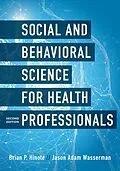Health professionals' interest in social and behavioral science is rapidly increasing due to the growing recognition that social factors such as income, education, race, gender, and age all impact individuals' health. These and other social conditions also shape patients' illness experiences, the ways that they interact with health care providers, and the effectiveness of with which health professionals provide care. Understanding these social determinants and applying them to clinical practice is a major challenge for healthcare providers, which is why programs and accrediting bodies have been including more social and behavioral science content into the curricula for medical, nursing, and allied health programs. Social and Behavioral Science for Health Professionals provides in-depth coverage of the social determinants of health and how to directly apply these insights in clinical practice, thereby enhancing clinicians' ability to engage their patients and more effectively render care. Broken into four parts, the book opens with the foundations of social science and health, including the shifting landscape of health and healthcare. The authors then cover the way in which social determinants of health shape large-scale features of health and illness in society, how they influence interactions between patients and providers in clinical settings, and how they shape health care systems and policies. Threshold concepts in each chapterfocus on conceptual and transformative learning while learning objectives, activities, and discussion questions provide instructors and students with robust sets of learning aids that intentionally focus on practical clinical, epidemiological, and policy issues. Ideal for students, educators, and professionals in health care, medical sociology, public health, and related fields, Social and Behavioral Science for Health Professionals is the only introduction available that clearly articulates why social and behavioral science matter in clinical care. New to This Edition: New Chapter 13 on Comparative Health Care Systems covers four models of health care systems and expands the global focus of the bookGreater emphasis on the LGBTQ+ community provides coverage of how gender expression and sexual orientation influence health and quality of care receivedNew coverage of current issues such as the opioid crisis and vaccine hesitancy that have been rendered especially important by the COVID-19 pandemic Added discussion questions at the end of every chapter strengthen students' critical thinking skills and abilities to apply new insights to practical, real-world examples.
Autorentext
Dr. Brian P. Hinote serves as professor and associate vice provost for data analytics and student success at Middle Tennessee State University. In addition to clinical and research experience in areas as diverse as pediatrics, neurology, and cell biology, Dr. Hinote's interdisciplinary work appears in multiple books and peer-reviewed journals in the social sciences, nursing, and medicine. His most recent work focuses on the various ways that social and behavioral science perspectives intersect and inform health care delivery and policy, clinical practice, and the work of various health professions. As a researcher and experienced educator, Dr. Hinote possesses valuable expertise working with students in various health fields as well as with health professionals already in the workforce.
Dr. Jason Adam Wasserman is associate professor of foundational medical studies and pediatrics at Oakland University William Beaumont School of Medicine, where he teaches bioethics and medical sociology. He also chairs the admissions committee for the medical school and serves as faculty advisor on professionalism. His scholarly work focuses on clinical ethics decision making, medical professionalism, the medicalization of homelessness, and the sociological impacts of the epidemiological transition on medicine. His first boo, At Home on the Street , explored sociological phenomena surrounding street homelessness.
Klappentext
Now in its second edition, Social and Behavioral Science for Health Professionals has been revised to further emphasize the ways in which medical, nursing, and allied health education are increasingly integrating social and behavioral science into their curricula. The expansion of courses in various professional programs to include fields like sociology and psychology attests to this shift, as do the most recent core competencies and content standards articulated by the major accrediting bodies in these fields.
Among a range of insights from medical sociology, the authors have also included a chapter on bioethics; a summary of the history of medicine and the emergence of modern health care practice; a discussion of interviewing strategies that emerge from the counseling literature; and detailed material on behavior change that more typically resides in psychology. Together, these cross-disciplinary social science insights respond to the needs of both current and future practitioners who are increasingly seeking this material in their fields of study and practice.
In recognition of the shift to include the social and behavioral sciences in medicine, nursing, and allied health curricula, this edition provides information directly related to the core competencies articulated by the following accrediting bodies:
AAMC (allopathic medicine)
AACOM (osteopathic medicine)
ADEA (dentistry)
CODA (dentistry)
ARC-PA (physician assistants)
AACN (nursing)
ACPE (pharmacy)
CCE (chiropractic)
Inhalt
Part I. Foundations of Social Science and Health
Chapter 1. Introduction to Health and the Sociological Imagination
Chapter 2. The Shifting Landscape of Health and Medicine: Past, Present, and Future
Chapter3. The Logic and Methods of Empirical Research
Part II.Social Epidemiology and Determinants of Health
Chapter 4. Social Class and Health
Chapter5. A Matrix of Health Inequalities
Chapter 6. Health Behavior and Lifestyles
Part III. Social Science in Clinical Practice
Chapter 7.Power, Medicalization, and Clinical Practice
Chapter 8. The Illness Experiences of Patients and Families
Chapter 9. The Social Dynamics of Clinical Communication
Chapter 10. Health Professions and Interprofessional Teamwork
Chapter 11. Bioethics, Social Science, and Clinical Practice
Part IV. Health Systems and Policy
Chapter 12. Health Care Systems and Policy
Chapter 13. Conclusion
